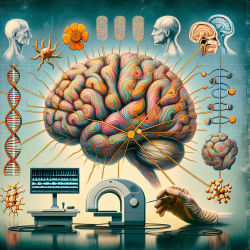Introduction
The increasing prevalence of Alzheimer's Disease (AD) and its precursor, Mild Cognitive Impairment (MCI), necessitates a deeper understanding of the associated motor dysfunctions. A recent systematic review titled "Neural Mechanisms of Motor Dysfunction in Mild Cognitive Impairment and Alzheimer’s Disease" provides valuable insights into the neural underpinnings of these motor deficits. This blog explores how practitioners can leverage these findings to enhance therapeutic outcomes for children, particularly through online therapy services like those provided by TinyEYE.
Understanding the Research
The systematic review by Koppelmans et al. (2022) analyzed 37 neuroimaging studies to elucidate the neural correlates of motor dysfunction in MCI and AD. Key findings highlighted that slower gait in individuals with these conditions is associated with reduced hippocampal volume and prefrontal deactivation. Additionally, excessive subcortical white matter lesions were linked to more pronounced parkinsonism symptoms and poorer functional mobility.
Implications for Practitioners
For practitioners, these findings underscore the importance of integrating motor assessments into cognitive evaluations. Here are some actionable steps:
- Early Identification: Incorporate gait analysis and dual-task performance assessments in routine evaluations to identify early signs of motor dysfunction.
- Holistic Approach: Consider the interplay between cognitive and motor functions. Tailor interventions that simultaneously target both domains, potentially enhancing therapeutic efficacy.
- Data-Driven Decisions: Utilize neuroimaging data to personalize therapy plans. Understanding the specific neural deficits can guide targeted interventions.
Encouraging Further Research
While the review provides a comprehensive overview, it also highlights gaps in the current literature, such as the need for longitudinal studies and larger sample sizes. Practitioners are encouraged to contribute to this growing field by integrating research into practice and collaborating with researchers to explore innovative therapeutic approaches.
Conclusion
The insights from this systematic review offer a promising avenue for enhancing therapeutic outcomes in MCI and AD. By adopting a data-driven, integrative approach, practitioners can better address the complex interplay of cognitive and motor dysfunctions in these conditions.
To read the original research paper, please follow this link: Neural Mechanisms of Motor Dysfunction in Mild Cognitive Impairment and Alzheimer’s Disease: A Systematic Review.










